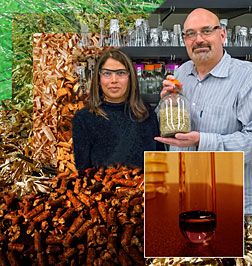- Number 385 |
- April 1, 2013
Vintage biofuel: a Joint Bioenergy Institute blend

At JBEI, Seema Singh and Blake Simmons
lead reasearch on blending biofuel
feedstocks.
Making a fine wine often means combining juices from just the right assortment of different grapes. Scientists at DOE’s Joint Bioenergy Institute (JBEI), led by DOE's Lawrence Berkeley National Laboratory (Berkeley Lab) and working with colleagues from Idaho National Laboratory (INL), have taken the first steps toward blending biofuels in the same way. Someday soon, biofuel blends could be tailored for specific uses, whether in cars, trucks, ships, trains, or jet planes.
Like wines, biofuels result from sugar fermentation by microbes. Unlike sugar from grapes, however, the sugars in fibrous lignocellulosic biomass are complex polysaccharides, deeply embedded within recalcitrant plant material called lignin. Pretreatment with ionic liquids – environmentally benign organic salts that can be substituted for volatile organic solvents in many chemical processes – helps break apart the complex lignocellulose, then hydrolyzes the polysaccharides into more easily fermented sugars that microbes can handle.
Another challenge in dealing with lignocellulosic feedstocks is their low density – both in terms of weight versus volume and the amount of energy they store in that volume. Bulky straw and wood, for example, store far less energy and are far more awkward to transport than coal or crude oil. Researchers at INL have been leaders in finding ways to increase the energy density of biomass feedstocks and make delivery to refineries more economical.
Yet another biofuel challenge is variability, both within and among species of potential biomass feedstocks, whether trees, grasses, or other plant sources. Milling feedstocks into flour or pellets is an effective method of large-scale energy densification, and tailoring a mixture of feedstocks could address the variability issue, but until the JBEI-INL study, how these processes would impact ionic-liquid pretreatment and sugar yield was unknown.
“Individual feedstocks within a given region are quite variable, depending on weather conditions, handling, storage, and crop variety,” says Seema Singh, director of JBEI’s Biomass Pretreatment group, who led the research with Blake Simmons, head of JBEI’s Deconstruction Division. “Blending and densifying different feedstocks to create a single uniform feedstock has been proposed, but not much scientific attention has been paid to the efficiency of converting mixtures of feedstocks into fermentable sugars and fuels.”
The research team started by combining individual feedstocks – they used switchgrass, lodgepole pine, corn stover, and eucalyptus – and grinding the mix into flour and also pressing it into pellets. The dense mixtures were then treated with JBEI’s benchmark biomass ionic liquid, 1-ethyl-3-methylimidazolium acetate.
The goal was to measure how efficiently the complex polysaccharides in the mixtures would be converted into fermentable sugars for fuel production. Within 24 hours of saccharification the team obtained sugar yields of up to 90 percent for both forms. The preferred form for commercial use is pellets, because of their relative ease of transport and higher energy density.
Simmons says, “Our results showed that an ionic liquid pretreatment can efficiently handle mixed feedstocks that have been milled and densified into pellets, and can generate high yields of fermentable sugars regardless of upstream processing.”
By showing that an ionic liquid already proven effective for pretreating individual biofuel feedstocks also works well with feedstock mixes, the JBEI-INL collaboration made the first demonstration that ionic liquid pretreatments can effectively handle mixed and densified feedstocks.
Says Simmons, “We’re continuing the JBEI-INL collaboration to identify the most economical pelletized feedstock mixtures based on targeted regions of the United States.”
Submitted by DOE’s Lawrence Berkeley National Laboratory
